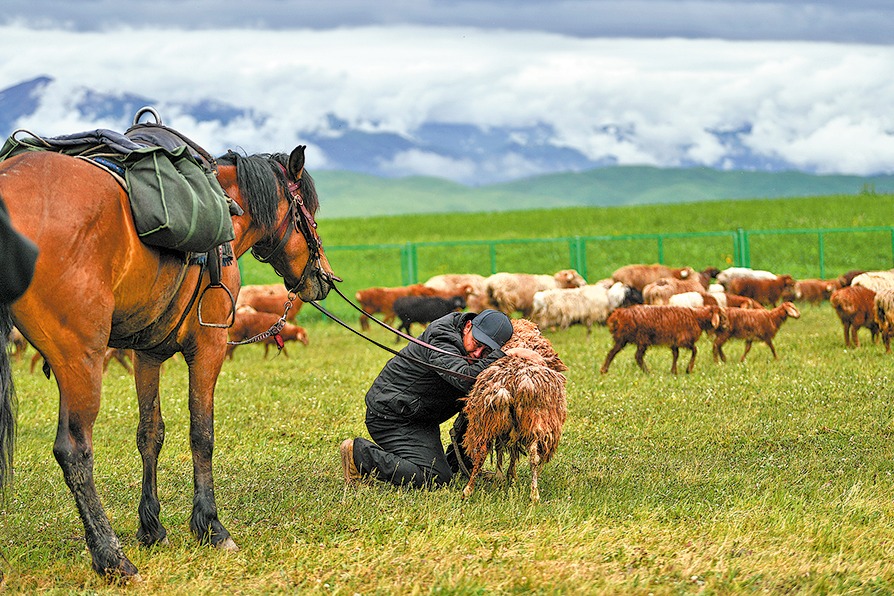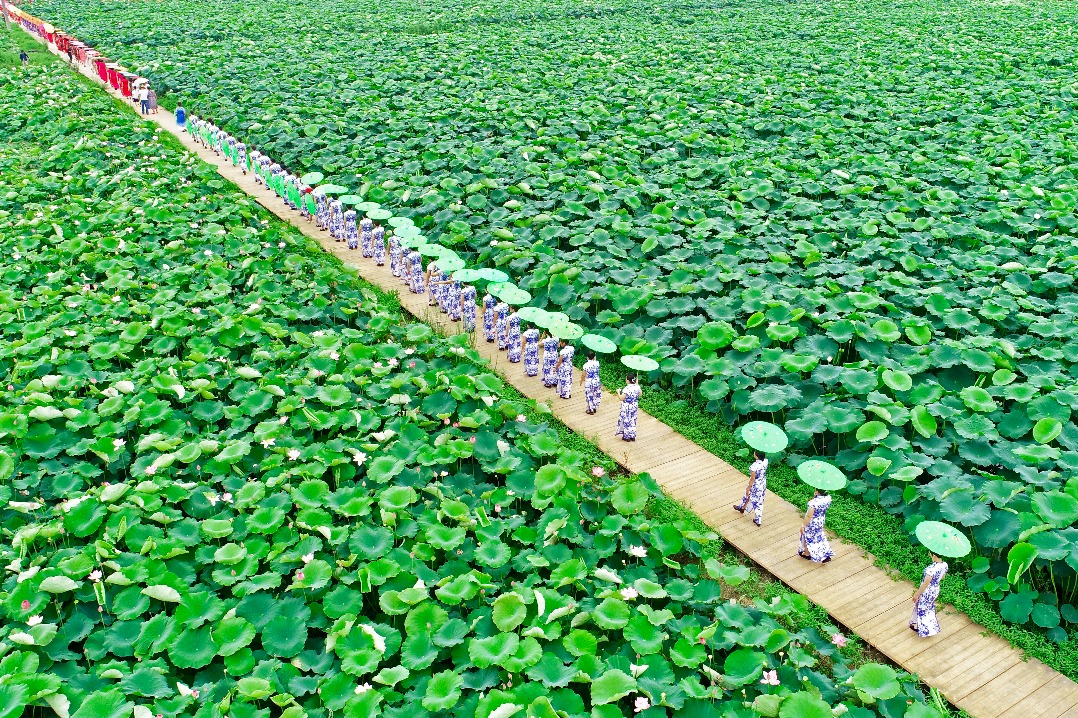Farmers plant roots in flowering lotus industry

In the height of the summer heat, the vast lotus ponds in Wangjiangjing town, Zhejiang province, stretch out in an endless sea of green.
Amid the rippling emerald waters, delicate pink blossoms quietly unfurl. A stroll along the water's ridges offers air filled with the sweet fragrance of lotus as streams of visitors weave through the scene to snap photos, with some rolling up their pants to wade into the pond to pick fresh seedpods.
This mass lotus field in the Liansidang scenic area in Xiuzhou district of Jiaxing, Zhejiang, has been carefully cultivated by Yao Zhongbao, head of the Zhongbao agricultural products cooperative.
"Tourists come here not only to get close to nature and enjoy the beautiful scenery, but also to taste fresh lotus seeds and take home handmade lotus root starch, organic lotus seeds, and lotus tea leaves produced by our cooperative," he says.
The wetlands are one of nature's precious gifts to Wangjiangjing. Since 2009, the town has leveraged its natural environment to develop a thriving wetland agriculture centered on lotus root, building a robust lotus industry.
Lotus thrives in warm, humid environments, tolerates waterlogging, and offers value in each part of the plant: the flowers are ornamental while the roots and seeds are prized for their culinary and medicinal uses.
The economic benefits of lotus farming have encouraged many villagers to participate, including Yao.

However, his journey with lotus plants wasn't always idyllic.
After years of growing lotus root, he began facing an invisible but persistent challenge — the soil, worn down from long-term cultivation, showed signs of fatigue, and the crops grew increasingly prone to disease.
"The land was tired. The lotus root wasn't growing as it used to," Yao recalls.
However, during a study trip organized by the local government, Yao's path took a turn. In 2015, he and his fellow farmers learned about new varieties of lotus that were being cultivated not just for their roots, but for seeds and flowers too.
"Our old fields were no longer suitable for lotus root," Yao explains, "so I decided to try the new varieties to see if I could grow lotus seeds."
At first, it was purely for practical reasons. The dry lotus seeds, used in traditional Chinese desserts like eight-treasure porridge, were harvested and processed for sale.
"I didn't think of selling flowers at the time," he says with a chuckle. "A few friends asked for some blooms as gifts, so I gave them away."
Five years later, in 2020, the flower side of his business began to show real promise.
Yao began to receive the occasional flower order.

By 2023, demand exploded thanks to an unexpected moment of online fame. A video of an elderly man carrying two baskets of lotus flowers on a shoulder pole went viral on Douyin, China's version of TikTok.
"That's when it really took off," Yao says. "Suddenly, everyone wanted a piece of the lotus field."
To cater to market demand, Yao has grown 350 mu (23.3 hectares) of ornamental lotus fields.
"This year, we're growing 16 varieties across four major color palettes, including single and double-petaled blooms," Yao explains. "The earliest varieties started blooming in May, and we'll be harvesting through October."
Not all lotus flowers are created equal, though; some fetch significantly higher prices. The Guanyin Lotus, for example, is a tightly-budded, double-petaled variety that requires a gentle hand to coax it open, earning it the nickname "pet flower" among growers.
Yao's fresh-cut lotus flowers are sold on site and distributed to major flower markets in Shanghai, as well as in Hangzhou and Jiaxing in Zhejiang.
Currently, the cooperative ships around 2,500 stems daily. Preliminary estimates show that one mu of ornamental lotus can generate revenue between 6,000 and 8,000 ($835-$1,114) yuan, far more profitable than lotus root farming.

Despite the growing success of his flower business, Yao still cultivates 86.7 hectares of lotus root, which he says maximizes the use of land and "nothing goes to waste".
To date, Wangjiangjing has nearly 666.7 hectares of lotus cultivation, with its annual output value reaching approximately 150 million yuan, says Liu Qixun, deputy head of the town.
Across town is one specialized lotus marketing cooperative, three lotus processing enterprises, and more than 60 lotus-growing households.
Beyond lotus flowers and roots, the two core products, Wangjiangjing's thriving lotus industry has sparked the development of a wide range of spin-off goods, from lotus root starch and sweet braised lotus to wonton wrappers, herbal lotus leaf tea, drinks, and lotus-flavored noodles.
Li Xiuying, chair of a local agricultural technology company, says it partnered with a major food company to produce lotus root starch wonton wrappers.
They're springy, translucent, and offer the distinct flavor of Jiangnan (the southern regions of the lower reaches of the Yangtze River). Consumers love them, Li says.




































